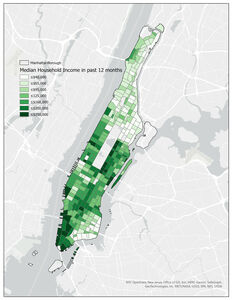1. Questions
With the recent increase in bicycling and the rise of bikeshare systems, a significant number of US cities and communities are investigating the use of bikeshare to improve the transportation system’s environmental, social, and health results. Researchers and scholars interested in bikeshare programs frequently concentrate their attention on the demographics of bikeshare customers. In addition to ethnicity, gender and educational attainment (Javid and Sadeghvaziri 2023), aspects such as income are factors that are taking into consideration (Sadeghvaziri et al. 2023). Given this, we ask: How does bikeshare usage differ with socio-demographics at Census Tract level in New York City?
2. Methods
As our study area, we used New York’s Citi Bike. Citi Bike is New York City’s bikeshare system and the largest bikeshare system in the US (“Citi Bike New Jersey | Citi Bike NYC,” n.d.). We used the most recent data of Citi Bike, from January 1st, 2023, to February 28th, 2023, for New York City, Manhattan Borough. During this period, Citi Bike data includes 3,607,349 trip records and each record includes the location of the origin of each ride (“Citi Bike System Data | Citi Bike NYC,” n.d.). Moreover, the independent variables were retrieved form the most current release of data from the American Community Survey (ACS). These variables includes median household income, race, number of workers, and gender in the past 5 years which were retrieved from the Census Bureau’s API for American Community Survey at the Census Tract level (U.S. Census Bureau, n.d.; “Esri’s Profile,” n.d.).
The data were imported into ArcGIS Pro. We regressed the CitiBike bikeshare rides on the aforementioned variables using the Generalized Linear Regression (GLR) built-in tool of ArcGIS Pro. Table 1 lists the dependent and independent variables.
As is demonstrated in Figures 1 and 2, bikeshare trips are highly concentrated in the downtown area and decay with distance from those centers with a smaller concentration of trip origins in the Uptown.
Using ACS data, Figure 3 presents median household income in past 12 months in New York City. It shows that household income decays with distance from the downtown with a lower income level households living in the north of the city.
3. Findings
Table 2 presents the regression model. The dependent variable is number of trips generated at each census tract during the two-month period.
The results of the model show that higher bikeshare ridership is associated with higher household income, a greater number of workers, greater number of males and higher density at the census tract level. Moreover, neighborhoods with higher African Americans and Hispanic population have less bikeshare ridership.
Based on the results of the analyses, it can be concluded that there is significant interaction between the levels of income groups and bikeshare ridership and we can conclude that bikeshare ridership is lower in low-income neighborhoods in New York City.
Acknowledgments
This is to acknowledge that there is no financial interest or benefit arising from the direct applications our research.






